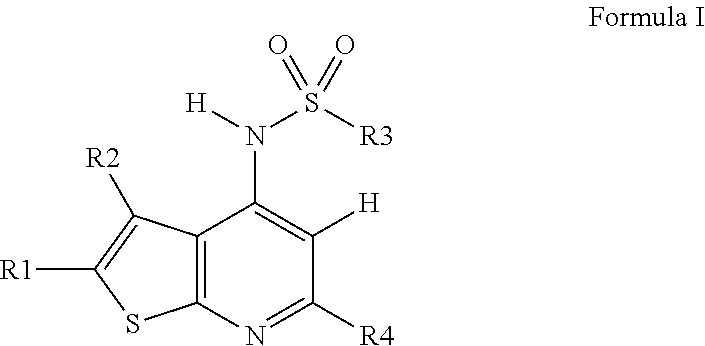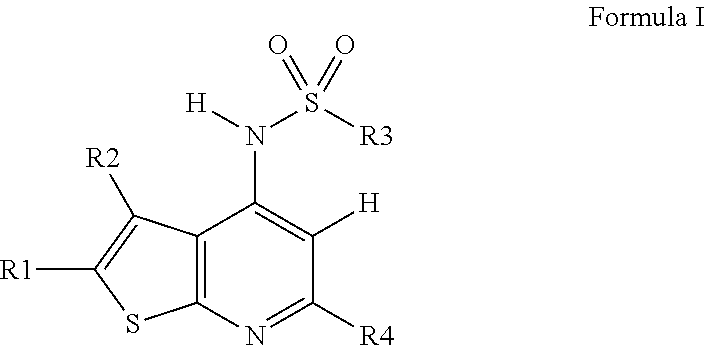Thienopyridine NOX2 inhibitors
a technology of thienopyridine and nox2, which is applied in the direction of biocide, cardiovascular disorder, drug composition, etc., can solve the problems of ros can irreversibly destroy or alter the function of target molecules, induce oxidative stress, genetic mutation,
- Summary
- Abstract
- Description
- Claims
- Application Information
AI Technical Summary
Benefits of technology
Problems solved by technology
Method used
Image
Examples
example 1
3-Chloro-N-{2,6-dimethyl-3-[3-(methyloxy)phenyl]thieno[2,3-b]pyridin-4-yl}-benzenesulfonamide
[0317]
[0318]To a stirred solution of 2,6-dimethyl-3-[3-(methyloxy)phenyl]thieno[2,3-b]pyridin-4-amine (Description 4) (100 mg, 0.352 mmol) in THF (2 mL), cooled in an ice bath, was added LiHMDS (1M solution in THF) (0.774 mL, 0.774 mmol). The reaction mixture was stirred at RT for 1 h before the addition of 3-chlorobenzenesulfonyl chloride (0.124 mL, 0.879 mmol). The reaction mixture was then stirred at RT for a further 12 h. The reaction mixture was then diluted with water (15 mL) and the aqueous layer extracted with DCM (3×30 mL). The combined organic extracts were dried over a phase separating column and concentrated. Purification by chromatography on silica gel, eluting with a gradient of 0-20% ethyl acetate in cyclohexane, afforded a solid which was dissolved in the minimum amount of DCM. Upon addition of diethyl ether, a solid precipitated out which was collected by filtration, washed ...
example 2
N-{2,6-Dimethyl-3-[3-(methyloxy)phenyl]thieno[2,3-b]pyridin-4-yl}benzenesulfonamide
[0319]
[0320]To a stirred solution of 2,6-dimethyl-3-[3-(methyloxy)phenyl]thieno[2,3-b]pyridin-4-amine (100 mg, 0.352 mmol) (Description 4) in THF (2 mL), cooled in an ice bath, was added LiHMDS (1M solution in THF) (0.774 mL, 0.774 mmol). The reaction mixture was stirred at RT for 45 min before the addition of benzenesulfonyl chloride (0.155 g, 0.879 mmol). The reaction mixture was then stirred at RT for a further 12 h. The reaction mixture was then diluted with water (15 mL) and the aqueous layer extracted with DCM (3×30 mL) and the combined organic extracts dried over a phase separating column and concentrated. MeOH (ca. 0.5 mL) was added to the residue which resulted in the precipitation of a solid. The solid was filtered, washed with MeOH (2 mL) and dried, to afford the title compound (88 mg). LCMS (A) m / z: 425 [M+1]+, Rt 1.40 min (basic).
example 3
3,4-Dichloro-N-{2,6-dimethyl-3-[3-(methyloxy)phenyl]thieno[2,3-b]pyridin-4-yl}-benzenesulfonamide
[0321]
[0322]Following the general method outlined in Example 2, starting from 3,4-dichlorobenzenesulfonyl chloride (0.216 g, 0.879 mmol), the title compound (79 mg) was isolated. LCMS (A) m / z: 493 [M+1]+, Rt 1.09 min (basic).
PUM
| Property | Measurement | Unit |
|---|---|---|
| enantiomeric excess | aaaaa | aaaaa |
| enantiomeric excess | aaaaa | aaaaa |
| enantiomeric excess | aaaaa | aaaaa |
Abstract
Description
Claims
Application Information
 Login to View More
Login to View More - R&D
- Intellectual Property
- Life Sciences
- Materials
- Tech Scout
- Unparalleled Data Quality
- Higher Quality Content
- 60% Fewer Hallucinations
Browse by: Latest US Patents, China's latest patents, Technical Efficacy Thesaurus, Application Domain, Technology Topic, Popular Technical Reports.
© 2025 PatSnap. All rights reserved.Legal|Privacy policy|Modern Slavery Act Transparency Statement|Sitemap|About US| Contact US: help@patsnap.com



